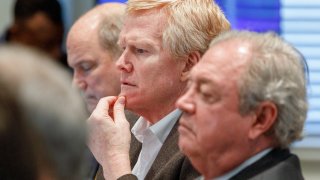
Alex Murdaugh and a friend spent just minutes planning a failed attempt to fatally shoot the lawyer on a lonely South Carolina roadside so his son could collect a multimillion-dollar life insurance policy, months after his wife and other son were shot to death, according to testimony Thursday in his double murder trial.
But the shot from a former client who turned into his drug dealer only grazed Murdaugh's head, a state agent testified .
That ruined Murdaugh's plan to make his death look like a robbery or revenge killing so his surviving son could collect his $10 million life insurance policy, according to an interview with Murdaugh and that the state agent played Thursday at this trial.
What in court is referred to as the “roadside shooting" is just the latest trial-in-a-trial in the murder proceedings against Murdaugh in the deaths of his wife Maggie Murdaugh, 52, and their 22-year-old son Paul Murdaugh. Their bodies were found June 7, 2021, at their Colleton County home.
Get Boston local news, weather forecasts, lifestyle and entertainment stories to your inbox. Sign up for NBC Boston’s newsletters.
Alex Murdaugh, 54, faces 30 years to life in prison if convicted of murder.
Judge Clifton Newman allowed testimony about the roadside shooting after the defense cross examination of a previous witness mentioned the former client, Curtis "Eddie" Smith, and how he might have kept some money Murdaugh intended to pay drug dealers for himself — and whether that might have led to the killings.
Prosecutors want to use the story to demonstrate that Murdaugh lies until he gets caught and has a pattern of solving problems with violence. The last trial-in-a-trial lasted several days and concerned Murdaugh stealing from clients and his family law firm.
U.S. & World
The shooting marked the public start to Murdaugh's downfall. Days later, his law firm said they fired him for stealing.
Eventually, Murdaugh would end up facing about 100 other criminal charges from insurance fraud for the roadside shooting, to theft, money laundering, drug dealing and tax evasion. He has yet to stand trial on those other charges.
In the interview with State Law Enforcement Division agent Ryan Kelly about a week after the roadside shooting, Murdaugh said he had just talked to one of his best friends “about everything I had done ... finances, pills, lies” on Sept. 4, 2021, and was in a bad place.
Murdaugh said he called Smith and that they met in the parking lot of a gas station.
“I told him this was getting ready to get really bad and I would be better off not here and I asked him to shoot me,” Murdaugh said.
Someone in the interview asked for Smith's response.
“At first he was a little surprised and then he said ‘OK,’” Murdaugh said.
Murdaugh gave his friend a pistol and drove to a lonely spot on a rural road. He punctured his tire and then waited. Smith pulled up, and Murdaugh said he didn't look at him.
“I stood close to the car and he shot me," Murdaugh said. "He missed and hit me in the very back of the head.”
Murdaugh first said he was shot by someone passing by as he tried to change the tire, even describing the alleged assailant in detail so a state agent could create a composite drawing.
“I apologize to you for lying in the hospital. I was in a very bad place,” Murdaugh told the agent.
Kelly told Murdaugh several times that he couldn't believe he didn't pay Smith to kill him. Murdaugh insisted it was a favor.
Murdaugh explained how he gave Smith money to buy drugs, maybe $50,000 a week and how he had been addicted to opioids for two decades.
“Where were those funds coming from?” Kelly asked.
“Let’s say most of them were not legitimately obtained,” Murdaugh's attorney Dick Harpootlian responded.
“Mr. Murdaugh is independently wealthy,” Kelly said.
“Not any more," Harpootlian responded.
Earlier Thursday, a crime scene expert testified that a mark on Maggie Murdaugh's thigh appeared to be tread from a golf cart tire that she fell on after she was shot near dog kennels on the family’s property. Defense lawyers had asked several witnesses about the blemish and whether it could be a mark from a shoe.
Most of Kenny Kinsey's testimony matched evidence presented by other witnesses about the brutality of Paul and Maggie Murdaugh's deaths.
Maggie Murdaugh was shot four or five times with a rifle just outside the kennels, while her son was shot twice with a shotgun inside a long closet where dog food and other supplies were kept.
Much of the focus of the questioning was about Paul Murdaugh's wounds, especially the second fatal shot that traveled at a steeper, upward angle from just above his waist and through his head.
Harpootlian used a ruler, protector and easel to draw the position of the shot and demonstrated with a shotgun the odd position the gun had to be in for that fatal shot. The weapons used in the killings have not been recovered.
Harpootlian's point was to show jurors that the shooter would have either been squatting or holding the shotgun with its powerful kickback at an odd angle.
Or, "the shooter was a very short person?” asked Harpootlian, who represents the 6-foot-4 (1.93-meter) Murdaugh.
Lead prosecutor Creighton Waters illustrated Maggie Murdaugh's wounds by getting on his hands and knees on the courtroom floor as Kinsey used a wooden rod to show the direction of the shots.



